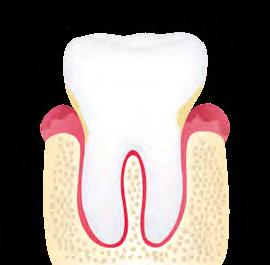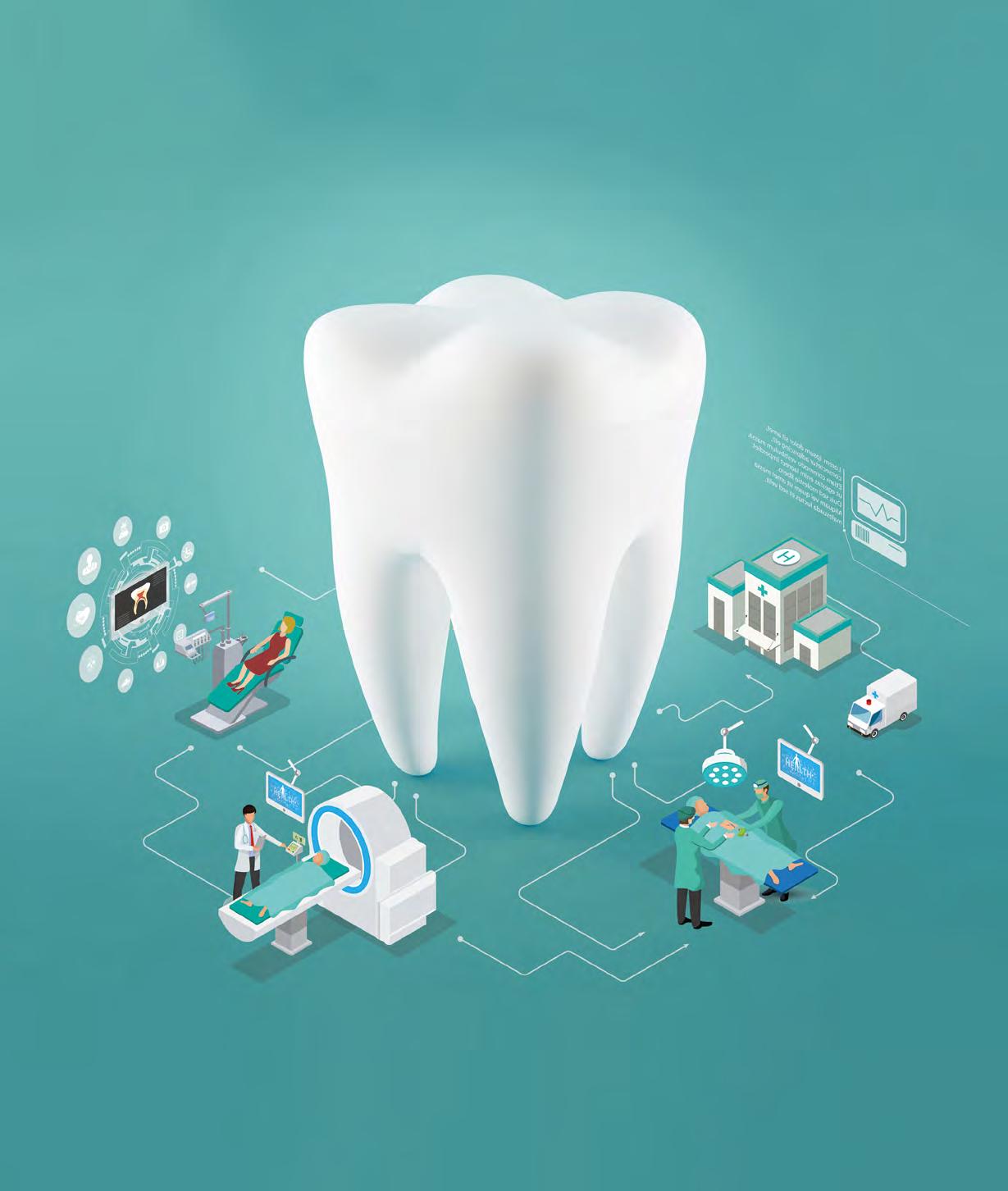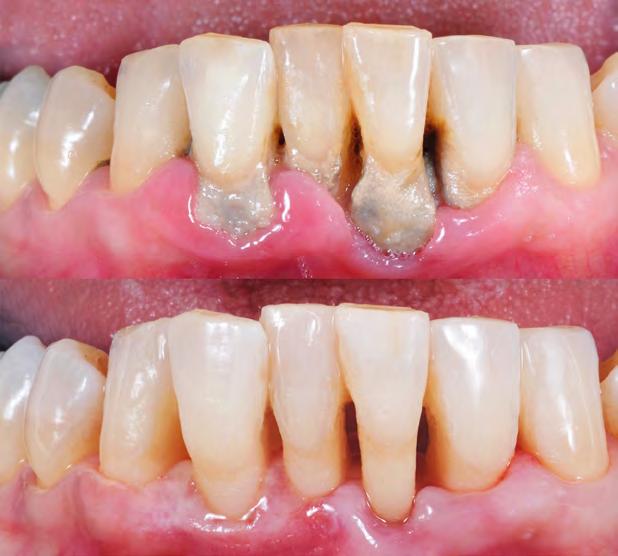
12 minute read
PERIODONTOLOGIA E PERIODONTITE PERIODONTOLOGY AND PERIODONTITIS
from HPA Magazine 14
Dr.ª Vanessa Malhado Castro
Médico Dentista Dentist
Advertisement
Hospital Particular do Algarve Alvor
Clínica Particular do Algarve AlgarveShopping · Guia
O QUE É A PERIODONTOLOGIA?
A periodontologia é a área da medicina dentária que se dedica ao estudo das patologias que afetam os tecidos que dão suporte aos dentes e os mantêm posicionados nos maxilares. O osso, o ligamento periodontal e as gengivas são responsáveis por este suporte e constituem o que se designa por periodonto.
Para além das funções anteriormente referidas, o periodonto é responsável por absorver os impactos das forças exercidas sobre os dentes, contribuindo assim para uma maior eficiência e conforto aquando da mastigação.
O QUE É A PERIODONTITE?
A periodontite é vulgarmente conhecida como uma doença das gengivas. Estima-se que afete cerca de 65% da população adulta e sabe-se que apresenta uma evolução crónica.
A periodontite é uma doença que acomete os teciWHAT IS PERIODONTOLOGY? Periodontology is the dental specialty that treats pathologies affecting the support tissue of the teeth, keeping them positioned in the jaw. The bone, the periodontal ligament and the gums are responsible for this support and are known as the periodontium. In addition to the previously mentioned functions, the periodontium is responsible for absorbing the impacts exerted on the teeth when chewing.
WHA IS PERIODONTITIS? Periodontitis is commonly known as a gum disease. It is estimated to affect approximately 65% of the adult population and its evolution becomes chronic. Periodontitis is a disease that affects the tissues that support the teeth to the jaw, namely the gums, the bone and the periodontal ligament. Periodontal disease is caused by bacteria and the persistent inflammation they cause. The bacteria respon

dos que suportam os dentes nos maxilares, nomeadamente as gengivas, o osso e o ligamento periodontal.
A doença periodontal é causada por bactérias e pela persistente inflamação local que estabelecem. O grupo de bactérias responsáveis pela periodontite fazem parte da constituição normal da flora bacteriana oral. No entanto, a acumulação regular e persistente de placa bacteriana e tártaro nas superfícies dentárias, pode desencadear um aumento drástico do número de bactérias periodontais. É por isso importante ressalvar que apesar de se tratar de uma doença bacteriana, a acumulação de placa bacteriana é apontada como a principal responsável pela instalação da doença.
A multiplicação bacteriana descontrolada em torno do periodonto, aliada a hábitos de higiene insatisfatórios e a uma falta de acompanhamento médico-dentário, estimula inicialmente uma resposta inflama- sible for periodontitis are part of the normal bacteria present in the mouth. However, regular and persistent accumulation of plaque and tartar on the surfaces of the teeth can trigger a drastic increase in the quantity of periodontal bacteria. It is therefore important to note that despite the fact that it is a disease caused by bacteria, the accumulation of plaque is responsible for the onset of the disease. The uncontrolled multiplication of bacteria around the periodontium, combined with unsatisfactory hygiene habits and a lack of medical and dental care, can cause an initial inflammation of the gums. However, with the progression of the disease, chronic inflammation will progresses along the periodontal tissues, leading to the destruction of the space between the gums and the teeth. This will in turn lead to the formation of periodontal pockets, ideal spots for the colonization and multiplication of periodontal bacteria.
tória ao nível da gengiva. Contudo, com a progressão da doença, instala-se uma inflamação crónica que progride ao longo dos tecidos periodontais levando a uma destruição da união entre a gengiva e o dente com a consequente formação de bolsas periodontais, locais de eleição para a colonização e multiplicação das bactérias periodontais.
Este é um processo que pode ser mais ou menos agressivo de acordo com o tipo de periodontite, bem como de acordo com o nível de progressão da doença quando é diagnosticada. O número e o tipo de bactérias presentes, a capacidade individual do sistema imunitário de cada paciente, assim como a presença de alguns fatores de risco, determinam a gravidade e
GENGIVA SAUDÁVEL HEALTHY GUM GENGIVITE GINGIVITIS
This process can be more or less aggressive depending on the type of periodontitis and also how far the disease has progressed once diagnosed. It is possible to determine the severity and progression rate of the disease. This depends on the quantity and type of bacteria, capacity of the patient's immune system, as well as other risk factors involved, the main ones being genetic, smoking habits, uncontrolled diabetes and the regular use of certain antihypertensive drugs.
WHAT ARE THE FIRST WARNING SIGNS TO WATCH OUT FOR?
One of the first warning signs is bleeding gums. Initially, gums will bleed when brushing the teeth. Gums
PERIODONTITE PERIODONTITIS

Gengiva Saudável Healthy Gum
Placa Plaque

Inflamação Inflammation
Placa Plaque

Raiz Exposta Exposed Root
taxa de progressão da doença. Como principais fatores de risco surgem a carga genética, os hábitos tabágicos, a diabetes descontrolada e o uso regular de certos fármacos anti-hipertensores.
QUAIS OS PRIMEIROS SINAIS A QUE DEVE ESTAR ATENTO?
Um dos primeiros sinais de alerta é o sangramento das gengivas. Inicialmente, o paciente verifica que o sangramento ocorre aquando a escovagem. A gengiva começa por ter uma alteração de cor e de forma, tornando-se mais avermelhada, edemaciada e por vezes, numa fase mais aguda, até dolorosa.
GENGIVITE VERSUS PERIODONTITE
As gengivas não estão totalmente aderidas aos dentes. Entre os dentes e as gengivas existe um pequeno espaço não percetível pelo paciente, que se designa por sulco gengival. Uma escovagem incorreta não será efetiva na remoção de todo o remanescente de placa bacteriana que se acumula no sulco gengival. A acumulação persistente de placa no sulco gengival leva à inflamação das gengivas. Nesta fase, instala-se a gengivite, isto é, verifica-se apenas uma inflamação das begin to change color and shape, becoming red, swollen and sometimes, in the more acute stages painful.
GINGIVITIS AND PERIODONTITIS Gums are not fully attached to the teeth. Between the teeth and the gums there is a small space not noticeable by the patient, which is called the gingival sulcus. Incorrect brushing will not remove the plaque that accumulates in the gingival sulcus. The persistent accumulation of plaque in the gingival sulcus leads to inflammation of the gums. At this stage, gingivitis sets in, that is, the gums become inflamed. Factors such as poorly adapted dentures or restorations, pregnancy, puberty and the use of certain drugs, can aggravate gingival inflammation. Gingivitis is a very common condition that can be easily treated with medical and dental care. When it is not diagnosed and treated in a timely manner, it may develop into periodontitis. However, it is known that each patient’s gum defense mechanism, response to treatment as well as genetic heritage play an important role in the progression of the disease, so it is important to note that not all gingivitis progresses to periodontitis.


gengivas. Fatores como próteses ou restaurações mal adaptadas, gravidez, puberdade e o uso de determinados fármacos, podem agravar a inflamação gengival.
As gengivites são uma condição muito frequente que pode ser facilmente tratada com acompanhamento médico-dentário. Contudo, quando não é diagnosticada e tratada atempadamente poderá evoluir para uma periodontite. No entanto, sabe-se que as capacidades de defesa e resposta das gengivas de cada paciente e a sua herança genética exercem um importante papel na progressão da doença, pelo que é importante referir que nem todas as gengivites evoluem para periodontite.
Quando é diagnosticada periodontite, a doença já se instalou. Verifica-se, portanto, uma destruição gradual e irreversível do periodonto.
Nesta fase mais tardia, o paciente poderá notar que o sangramento gengival pode ocorrer durante a mastigação ou ser espontâneo; ter queixas de mau hálito; verificar uma alteração da posição dentária; observar a ocorrência de espaçamentos entre dentes; ter a sensação de dentes mais alongados devido à ao processo de recessão gengival (retração das gengivas) e em alguns casos mais raros experienciar dor.
Em fumadores, devido ao efeito da nicotina sobre os vasos sanguíneos da gengiva, os primeiros sinais de inflamação gengival podem ser menos evidentes e mascarar a doença.
É crucial ressalvar e reter a ideia de que uma gengiva saudável não sangra, nem mesmo durante a escovagem. O paciente deve consultar o seu médico-dentista caso a situação se verifique.
QUAL O TRATAMENTO DA PERIODONTITE?
O foco do tratamento da doença periodontal é a eliminação da placa bacteriana das bolsas periodontais de modo a parar a progressão da doença.
When periodontitis is diagnosed, the disease has already set in. Therefore, there is a gradual and irreversible destruction of the periodontium. At this stage, the patient may notice bleeding gums when chewing or even spontaneously; bad breath; alteration in the positioning of some teeth; spacing between teeth; seemingly elongated teeth due to receding gums and rarely, pain may be experienced. In smokers, due to the effect of nicotine on the blood vessels of the gums, the first signs of gum inflammation may be less evident and hide the disease. It is crucial to understand and remember that healthy gums do not bleed, even during brushing. The patient should consult his dentist if this should occur.
WHAT IS THE TREATMENT FOR PERIODONTITIS? The object of periodontal treatment is the elimination of plaque from the periodontal pockets to stop the progression of the disease.
PERIODONTOGRAM During the initial phase, the dentist will register on a periodontogram all the periodontal pockets and assess the destruction of the periodontal tissues which has already occurred. The periodontogram together with the patient's clinical history will help to reach a diagnosis of the type, at what stage and how far the periodontal disease has progressed.
INSTRUCTIONS ON ORAL HYGIENE Educating and motivating the patient on oral hygiene habits is crucial to the success of treatment. The dentist will provide the tools and establish the conditions for the patient to control the accumulation of plaque. However, collaboration and commitment is the key to a successful treatment. It is also important to note that even with very disciplined patients in oral hygiene, the disease may recur. This is due to genetics being a contributing factor and also the patient's tendency towards periodontal disease.
riodontograma onde o médico-dentista fará um mapeamento de todas as bolsas periodontais e avaliará a destruição dos tecidos do periodonto. O periodonto grama em conjunto com a histórica clínica do paciente, permite estabelecer um diagnóstico de que tipo de pe riodontite se trata, bem como prever a taxa de progressão em que a doença se encontra.
INSTRUÇÕES DE HIGIENE ORAL
A instrução e motivação do paciente sobre hábitos de higiene oral verifica-se crucial no sucesso do tratamento. O médico-dentista fornecerá as ferramentas e estabelecerá as condições para permitir que haja o controlo da acumulação de placa bacteriana por parte do paciente. No entanto, a colaboração e empenho deste são a chave para o sucesso do tratamento. Será importante referir também que mesmo em pacientes muito disciplinados com a higiene oral, poderão ocorrer reincidências da doença. Isto acontece devido à grande dificuldade em contrariar a componente genética e tendência do paciente para a doença periodontal.
Destartarização e Alisamento Radicula
Com recurso à destartarização ou limpeza profissional, é feita a remoção mecânica da placa bacteriana e tártaro aderidos às superfícies dentárias. Após a destartarização é realizado um alisamento das raízes de modo a torná-las superfícies mais lisas, removendo e atrasando a colonização bacteriana.
Cirurgia Corretiva
Em alguns casos, quando a periodontite já está muito avançada, existem bolsas periodontais muito profundas onde se acumulam depósitos de tártaro. Com a escovagem ou mesmo com ajuda médica com recurso apenas à destartarização ou com a raspagem das raízes, não é possível garantir a correta higienização destas bolsas.
Nestes casos, sob anestesia local, é feito um levantamento das gengivas e exposição das raízes, permitindo uma eficiente descontaminação.
A cirurgia periodontal corretiva para além de ser um método de higienização das bolsas mais profundas, permite também modelar e reposicionar as gengivas criando condições mais favoráveis ao paciente para fazer um eficiente controlo de placa. Em alguns casos, é mesmo possível fazer uso de técnicas de regeneração de osso e ligamento perdidos devido à doença.
TERAPIA DE SUPORTE/MANUTENÇÃO
A terapia de suporte/manutenção inicia-se quando se verifica a estabilização da doença periodontal. Nesta fase, todas as etapas do tratamento já terão sido executadas e a reavaliação da condição periodontal permite conduzir o paciente para a terapia de suporte. O paciente estará apto a ser conduzindo para esta fase quando se verificar capaz de fazer um controlo de placa efetivo e manter o seu periodonto reduzido saudável, isto é, sem focos de inflamação e infeção.
Caberá ao médico-dentista determinar com que frequência o paciente deverá fazer consultas de controlo, tendo por base a responsabilidade e disciplina do paciente, bem como a taxa de progressão e severidade da doença e o risco individual de cada individuo.

SCALING AND ROOT PLANNING By professional scaling and polishing, plaque and tartar which has adhered to the surface of the teeth can be mechanically removed. After scaling, roots are smoothed down resulting in a smoother surface, removing and delaying the accumulation of bacteria.
CORRECTIVE SURGERY In some cases, when periodontitis is already very advanced, there are very deep periodontal pockets where deposits of plaque accumulate. With brushing or even medical help such as scaling of the teeth and roots, it is not possible to guarantee the correct hygiene of these pockets. In these cases, the gums are lifted and the roots exposed, allowing an efficient decontamination of the whole area. This is done under local anesthesia. Corrective periodontal surgery, in addition to being the only way of cleaning these deep pockets, can also remodel and reposition the gums, creating the necessary conditions for the patient to control plaque efficiently. In some cases, it is even possible to make use of bone and ligament regeneration techniques, lost due to the disease.
SUPPORT / MAINTENANCE THERAPY Support / Maintenance treatment begins when periodontal disease has been stabilized. At this stage, all phases of the treatment will have been completed and the reevaluation of the periodontal condition allows the patient to be referred for maintenance treatment. The patient will only be referred to this stage of the treatment when he is able to control the accumula tion of plaque effectively and keep his periodontium healthy, that is, without inflammation and infection. It will be up to the dentist to determine how often the patient should maintain his control visits. This will be based on the patient's responsibility and discipline, as well as the rate of progression of the disease, its severity and the individual risk.








